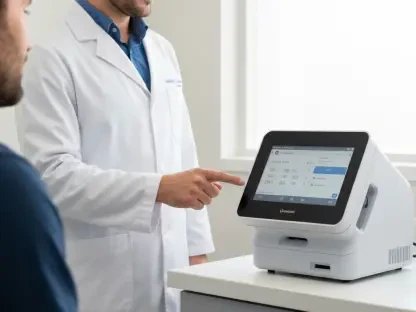In recent years, the exploration of predictive biomarkers in chronic pain management has garnered substantial attention, promising a potential paradigm shift in how this pervasive issue is addressed. Chronic pain affects over 50 million Americans and continues to challenge the healthcare system, with current treatment methods largely focused on symptom management rather than prevention. With the opioid crisis serving as a stark reminder of the necessity for improved chronic pain solutions, researchers are now turning to innovative strategies, such as predictive biomarkers, to forecast and potentially mitigate chronic pain more effectively.
The Role of Biomarkers in Chronic Pain
Unraveling the Complexity of Pain Prediction
The endeavor to uncover reliable predictive markers for chronic pain is not just a scientific pursuit but a pressing clinical necessity due to the limitations of current medical practices. Pain researchers have long theorized that early detection of individuals predisposed to chronic pain could prevent its onset, thus reshaping treatment paradigms. While functional magnetic resonance imaging (fMRI) has identified parameters that hint at chronic pain predispositions, challenges persist regarding reproducibility across different labs and pain types. A. Vania Apkarian, a noted pain researcher, emphasized the partial solutions offered by fMRI-derived biomarkers, indicating a broader requirement for innovations in this domain.
Recent studies have highlighted the potential of alternative technologies such as electroencephalography (EEG) and transcranial magnetic stimulation (TMS). These tools can capture brain activity related to pain processes more conveniently and at a fraction of the cost of traditional methods. The intersections of these technologies with chronic pain research suggest a promising direction for creating effective interventions. The ability to reliably predict who might suffer from chronic pain opens the door to preventative measures, which could significantly reduce the burden on healthcare systems and improve patient well-being.
Innovative Study Designs in Pain Research
The breakthrough study spearheaded by neuroscientist David Seminowicz at the University of Western Ontario implemented an innovative method to better understand predictive biomarkers. By ethically inducing pain through nerve growth factor injections in participants’ jaws, the research established a controlled environment to study pain dynamics akin to chronic conditions. This approach enabled the analysis of specific biomarkers, particularly peak alpha frequency (PAF) and corticomotor excitability (CME), which were measured using EEG and TMS respectively. These markers are postulated to provide insights into pain processing in the brain and the resulting motor responses.
Participants were asked to report pain levels during activities like chewing and yawning, with initial pain perceptions varying among individuals. Subsequent logistic regression analysis revealed that these biomarkers could predict whether a participant would experience high or low pain over the following month. Results demonstrated perfect prediction accuracy in the initial participant group, with 88 percent accuracy in a subsequent smaller test group. This level of precision marks a significant advancement in chronic pain prediction research and suggests a new pathway for personalized medical interventions.
The Potential of EEG and TMS in Clinical Settings
Bridging Research with Clinical Applications
Translating the promising findings of predictive biomarkers into clinical practice is a critical next step that researchers are actively pursuing. One area of focus is understanding how predictive models can be integrated into decisions regarding elective surgeries. These models could empower patients and doctors to better assess the risks of developing prolonged chronic pain post-surgery. The implications of such integration are profound, potentially reducing unnecessary surgeries and enhancing postoperative care planning. However, this promising direction necessitates rigorous clinical validation to ensure reliability and applicability across diverse patient populations and settings.
Ongoing studies are examining the relevance of PAF and CME in patients with temporomandibular disorder (TMD), a condition often evolving from acute to chronic pain. While initial findings are encouraging, complexities remain. For instance, PAF is influenced by various external factors, such as sensory stimuli and caffeine intake, which could affect its specificity for chronic pain prediction. Thus, further research is needed to refine these biomarkers’ roles in clinical settings, focusing on comprehensive analyses that distinguish genuine pain-indicative changes from unrelated fluctuations.
The Broader Implications for Pain Management
The broader implications of this research extend beyond the specifics of EEG and TMS application. By identifying individuals at risk of chronic pain before symptoms fully develop, healthcare providers could offer preemptive treatments designed to prevent chronic pain’s onset. This preventative approach aligns with a growing emphasis on personalized medicine, aiming to tailor interventions to individual patient profiles. Moreover, the shift from treating symptoms to preventing the condition holds the promise of significant reductions in healthcare costs and improvements in patients’ quality of life.
Additionally, the insights gained from exploring these biomarkers contribute to a deeper understanding of pain mechanisms. This knowledge can guide the development of new therapeutic targets, potentially leading to innovative treatment options. While challenges remain in translating scientific discoveries to practical solutions, the potential benefits bolster continued research. Innovative approaches in predictive biomarkers for chronic pain might illuminate paths to breakthroughs not only in pain management but also in other chronic conditions, amplifying the positive impact across various medical fields.
Moving Toward a New Era in Pain Management
Charting the Course for Future Research and Application
The intersection of neuroscience and clinical practice through the lens of predictive biomarkers signifies a promising forefront in chronic pain management. The potential to predict and prevent chronic pain offers a paradigm shift from traditional reactive treatments to proactive, patient-centered care. As researchers continue to explore and validate these innovative approaches, the ultimate goal is to establish a framework that seamlessly integrates predictive biomarkers into standard medical practice. Achieving this vision requires ongoing collaboration between researchers, clinicians, and patients to refine these models’ accuracy and practicality.
Looking to the future, the successful application of these predictive biomarkers could fundamentally alter the landscape of pain treatment. By facilitating early interventions and empowering patients with actionable insights, healthcare providers can potentially avert the evolution of acute pain into chronic conditions. As the field progresses, embracing a multidisciplinary approach that leverages advancements in technology and insights from various medical disciplines will be key to overcoming current limitations and enhancing pain management strategies.
Reflecting on the Path Forward
In recent years, the study of predictive biomarkers for chronic pain management has gained significant interest, offering hope for a transformative change in addressing this widespread issue. Chronic pain impacts over 50 million Americans, posing ongoing challenges for the healthcare industry. Traditional treatment approaches remain heavily focused on managing symptoms instead of proactively preventing pain. The opioid epidemic has starkly highlighted the urgent need for better solutions in chronic pain management. This has driven researchers to pursue novel strategies, such as predictive biomarkers, which have the potential to not only forecast but also effectively reduce chronic pain occurrences. Predictive biomarkers could eventually lead to personalized treatment plans, tailoring interventions to individual patient needs. This anticipatory approach could revolutionize pain management, shifting from a reactive to a proactive model, enhancing patient outcomes, and possibly reducing the reliance on opioids in the long run.









